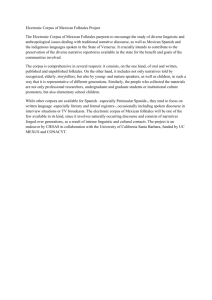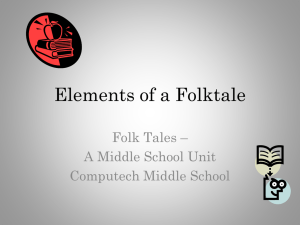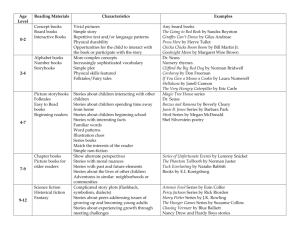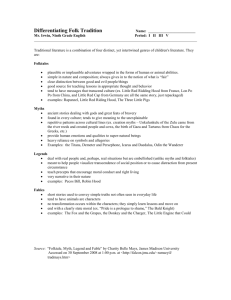Chinese Folktales
advertisement
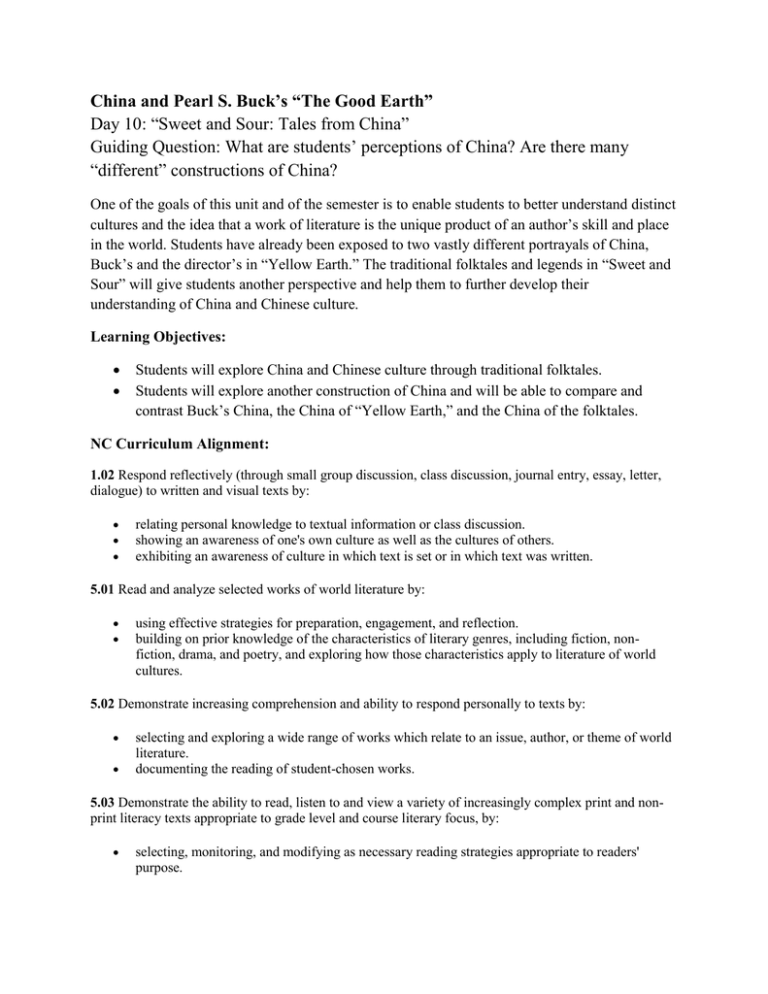
China and Pearl S. Buck’s “The Good Earth” Day 10: “Sweet and Sour: Tales from China” Guiding Question: What are students’ perceptions of China? Are there many “different” constructions of China? One of the goals of this unit and of the semester is to enable students to better understand distinct cultures and the idea that a work of literature is the unique product of an author’s skill and place in the world. Students have already been exposed to two vastly different portrayals of China, Buck’s and the director’s in “Yellow Earth.” The traditional folktales and legends in “Sweet and Sour” will give students another perspective and help them to further develop their understanding of China and Chinese culture. Learning Objectives: Students will explore China and Chinese culture through traditional folktales. Students will explore another construction of China and will be able to compare and contrast Buck’s China, the China of “Yellow Earth,” and the China of the folktales. NC Curriculum Alignment: 1.02 Respond reflectively (through small group discussion, class discussion, journal entry, essay, letter, dialogue) to written and visual texts by: relating personal knowledge to textual information or class discussion. showing an awareness of one's own culture as well as the cultures of others. exhibiting an awareness of culture in which text is set or in which text was written. 5.01 Read and analyze selected works of world literature by: using effective strategies for preparation, engagement, and reflection. building on prior knowledge of the characteristics of literary genres, including fiction, nonfiction, drama, and poetry, and exploring how those characteristics apply to literature of world cultures. 5.02 Demonstrate increasing comprehension and ability to respond personally to texts by: selecting and exploring a wide range of works which relate to an issue, author, or theme of world literature. documenting the reading of student-chosen works. 5.03 Demonstrate the ability to read, listen to and view a variety of increasingly complex print and nonprint literacy texts appropriate to grade level and course literary focus, by: selecting, monitoring, and modifying as necessary reading strategies appropriate to readers' purpose. identifying and analyzing text components (such as organizational structures, story elements, organizational features) and evaluating their impact on the text. identifying and analyzing personal, social, historical or cultural influences, contexts, or biases. making connections between works, self and related topics. analyzing and evaluating the effects of author's craft and style. analyzing and evaluating the connections or relationships between and among ideas, concepts, characters and/or experiences. identifying and analyzing elements of literary environment found in text in light of purpose, audience, and context. Materials: Multiple copies of “Sweet and Sour: Tales from China.” Try to have at least five for students to look through during their writing assignment. Copies of at least three (four would be better) short folktales from “Sweet and Sour,” have enough copies for entire class. Include “The Clever Wife,” “Ten Jugs of Wine,” “From Bad to Good to Bad to Good,” and “The Monk and the Drunk.” PowerPoint of images that supplement the reading of Chinese folktales. [It might be interesting and fun for the students to have classical or rural Chinese music playing to accompany the reading of these folktales; after all, the purpose of this unit is cultural exposure through literature and writing.] Students should have their copies of “The Good Earth” with them. Procedures: Daily Writing Prompt/Class Warm-Up (10 minutes) 1. The prompt for today’s class period: “Folktales are an important part of every culture. In many cultures, folktales are taught to young children in order to instill cultural values like respect, honesty, etc. For your journal, describe your favorite folktale in a brief paragraph then rewrite it in your own words. You can add and take things away, but remember, the purpose of a folktale is to teach the reader a lesson.” Lesson: (60 minutes) 1. [Daily writing prompts are often fun, interesting prompts like “Spend ten minutes writing a scene that involves: a computer disk, a bonfire, an antique vase, an elevator, and a church pew.” During literature units like “The Good Earth,” prompts often supplement or echo the lesson for the day.] You all have just finished writing your own twist on a folktale. Why do you believe that folktale is your favorite? What about it makes you like it so much? The characters, plot, moral, theme? Why do you believe folktales are such an important part of nearly every culture in the world? [A lesson on folktales was given earlier in the semester; this is a refresher of sorts.] If folktales are so important, and are the product of centuries of telling and re-telling, do they provide insight into their 2. 3. 4. 5. respective cultures? Can we learn anything about Appalachia by reading Jack Tales? Or about Germany and other parts of Europe when reading the Grimms Brothers? “Last week, we discussed Pearl S. Buck’s life and how her experiences helped shape her perception of China. Earlier in the semester, we talked about how authors unconsciously add their own values, beliefs, and prejudices to their writing. With Buck, that led to her portraying the Chinese in a very sympathetic light when others around the world were disparaging them. We watched “Yellow Earth” last week; it was produced by Chinese filmmakers and presented a very different early 1900s rural China. Today, we are going to be reading out of “Sweet and Sour: Tales from China,” a book of Chinese folktales, in order to see yet another China.” Pass out copies of the three (four) Chinese folktales selected for the lesson. How many of you believe folktales are important? Ok, how many don’t? What about those of you who didn’t raise your hand? Proceed to ask a few of the students of each camp why they hold that opinion. For those of you who believe folktales are insightful, here are some Chinese folktales—be enlightened. The rest of you had some very good points about why you think folktales tell very little about a culture. I would like you to keep that in mind while reading these and see if that holds true at the end. Remember to look at these as historical documents and compare them to the information you’ve already learned about China. If there are correlations between the two, does that mean folktales contain a grain of truth? Read the first folktale aloud yourself. Be sure to be animated in order to engage the students. For the second folktale, ask for volunteers. Break it up so several students can read a portion of the folktale aloud. Allow the students to read the others silently. Discuss each after finishing. Give the students plenty of time to read the remaining folktales. Have them read them in a specific order, and after everyone has finished one tale, discuss what it was about, both literally and figuratively. Students can read on once they’ve finished, but they should be prepared to discuss each tale even if they’ve already started another. After every student has finished reading all of the folktales, begin a discussion about what they say about China. What have you learned about China from these folktales that you didn’t already know? Did you find anything that wasn’t mentioned in either “The Good Earth” or “Yellow Earth?” Why do you believe that wasn’t mentioned? Do these folktales present a different China from the one you have read about or seen in films? If folktales are the product of centuries of storytelling, are they true and Buck’s novel false? No? So, you mean that both the folktales and Buck’s story of Wang Lung are both true to China even though they are very different? How is that possible? Assessment: (20 minutes) 1. Students will complete a short writing assignment; it should be at least a page in length. Write the prompt for this writing assignment on the board. Now that you’ve read almost all of “The Good Earth” and have read these folktales, I want you to grab a piece of paper. Compare and contrast the Chinas presented in Buck’s story and in these traditional folktales. How are they different? How are they the same? If, as we discussed, both of these representations of China are true, how do you reconcile the two differing perceptions? 2. Collect the writing assignments at the end of the class. As usual, don’t grade these short handwritten assignments for mechanical accuracy; grade them on their ability to reference the folktales and “The Good Earth.”
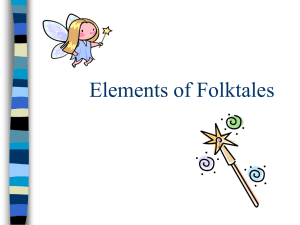
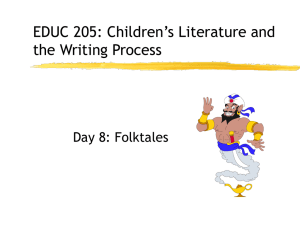
![Essay #4: [4 Short essays will substitute Essay 4]](http://s3.studylib.net/store/data/007737676_2-779981057889e025637152af438b827f-300x300.png)
